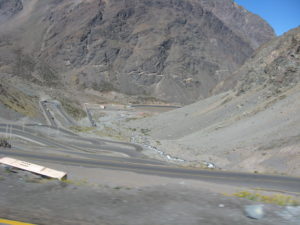Los Caracoles here we come
The intrepid ones have crossed the Andes by bus! What an adventure. These are not hills. How to describe them? Majestic? Absolutely! Stupendous? Sure. Verdant? Not on this Chilean side. They are so bare in places you can see the seams of minerals that abound in them, beautiful in their own way.
We watched the birth of rivers from the snow capped mountain peaks become rushing white waters that morph into dirt coloured roaring rivers carving their way through the crags and fissures of the mighty Andes. The views are magnificent with numerous waterfalls, huge craggy outcrops bereft of sediment, and snow capped vistas so close you think you can touch them.
We were on our way from Santiago, Chile to Mendoza, a city in the Andes in Argentina. This mountain pass called the Paso Los Libertadores climbs through the Andes to an elevation of approximately 10, 500 feet to a plateau where sits the Customs and Immigration centre at the Chilean/Argentinean border. We had left Santiago where the temperature was 28C nearly four hours prior and now it is 15C. That is fine. Food is scarce, snacks only. That’s fine too. The line at Passport Control is long as there are six buses ahead of ours and you must first officially exit Chile then join another line about twenty paces to the right for official entry into Argentina. This is frustrating but you remain calm as you can’t do anything about it in any case. Also, it gives your stomach some time to settle as it is the getting to this point that is troublesome, which is the understatement of any year.

Before you can get to this border you would have travelled through a section of this main road called Los Caracoles, the snails. This road has been designated one of the most winding roads in the world. If you should see it from an airplane it would resemble the coils of a refrigerator. The hairpin turns turn on themselves. It is a hair- raising journey.
I am not sure what the signs that indicate the number of the curve you are negotiating are supposed to do. Will you need to tell a friend to meet you at curve number eight up the Andes Mountain? Are they to tell you how far you have come? That may be a possibility except I am convinced that the curve counters cannot count. I was getting dizzy as we climbed and I was certain we had negotiated at least a few thousand curves when I looked out the window and saw a sign reading ‘curva 21’, curve 21. Impossible! Where did they begin their count? “Those are just Los Caracoles”. So they say. Even more harrowing is the fact that there are no guardrails. I found I was drawing myself up whenever another vehicle approached, as if that could help. Bert, he who is afraid of heights, kept his eyes closed while I prayed.
After three days in Mendoza it was back on the bus. I would like to tell you it was easier. Not at all. The Argentinean side of the mountain is quite different from the Chilean side. The road meanders beside the Mendoza River and there are grape arbours, farms and many sightings of old abandoned mines. It is a nice slow climb. However, this is just the calm before the storm as you have to face the downward journey to Santiago.
If you are unfortunate enough to be sitting on the right side of the bus you are treated to seeing the front actually hanging over the edge of the mountain as you hope that the wheels will remain on the road. Take a peak downward and you see a convoy of snails, trucks, that is, snaking down. Their cabs are also over the cliffs as they make the turns. Breathe, just breathe.
We have spent some winters in Chile and have dared to do this round trip journey five times. It is still terrifying.
The Meander: At the border, I noticed many of us were looking at the seven meter high bronze statue of Christ the Redeemer of the Andes while others looked back towards Aconcagua, the highest mountain in the Western and Southern hemispheres. It seemed as if we were suspended between heaven and earth but I did not know which was which.

